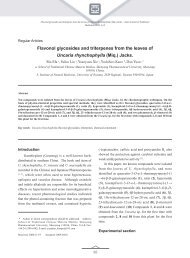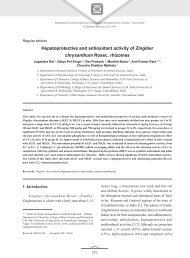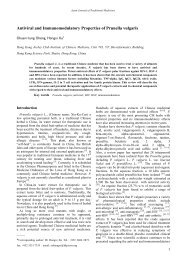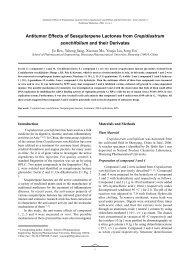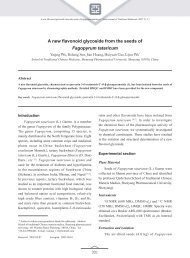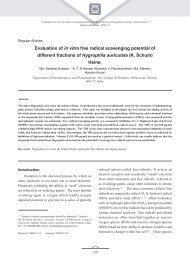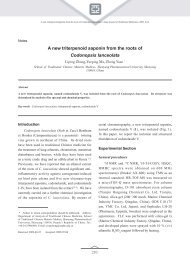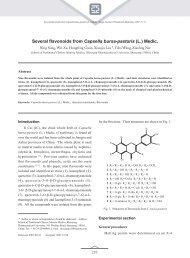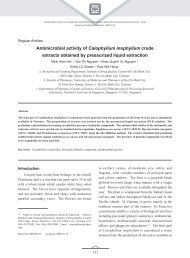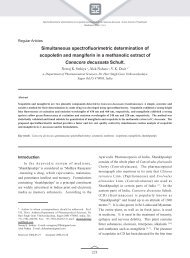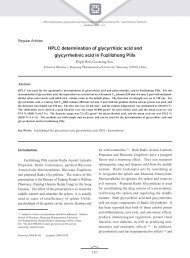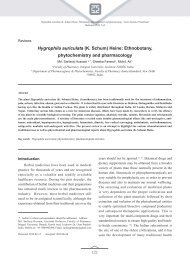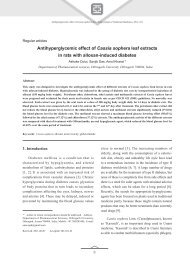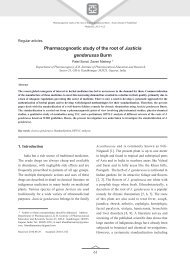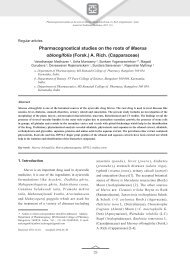Ayurvedic uses and pharmacological activities of Calotropis procera ...
Ayurvedic uses and pharmacological activities of Calotropis procera ...
Ayurvedic uses and pharmacological activities of Calotropis procera ...
Create successful ePaper yourself
Turn your PDF publications into a flip-book with our unique Google optimized e-Paper software.
<strong>Ayurvedic</strong> <strong>uses</strong> <strong>and</strong> Pharmacological <strong>activities</strong> <strong>of</strong> <strong>Calotropis</strong> <strong>procera</strong> Linn. / Asian Journal <strong>of</strong><br />
Traditional Medicines, 2011, 6 (2)<br />
Reviews<br />
<strong>Ayurvedic</strong> <strong>uses</strong> <strong>and</strong> <strong>pharmacological</strong> <strong>activities</strong> <strong>of</strong><br />
<strong>Calotropis</strong> <strong>procera</strong> Linn.<br />
Ajay Kumar Meena *, Ajay Yadav, M M Rao<br />
National Institute <strong>of</strong> <strong>Ayurvedic</strong> Pharmaceutical Research, Patiala 147001, Punjab, India<br />
Abstract<br />
Herbal medicines have been used from the earliest times to the present day. The ethnobotanical pharmacology is as old as man<br />
himself. Herbal medicines exhibit a remarkable therapeutic diversity. <strong>Calotropis</strong> <strong>procera</strong> Linn. is an <strong>Ayurvedic</strong> plant which is<br />
used in several traditional medicines to treat a variety <strong>of</strong> diseases. The extracts from different parts <strong>of</strong> the plant have significant<br />
therapeutic value. The whole plant when dried exhibits good tonic, antihelmintic <strong>and</strong> expectorant <strong>activities</strong>. The roots also have<br />
similar <strong>activities</strong> <strong>and</strong> also ac as an effective laxative. Traditionally, the powdered rot is used to treat bronchitis, asthma, leprosy,<br />
eczema, elephantiasis while the latex s used to, treat vertigo, baldness, hair loss, toothache, intermittent fevers, rheumatoid/joint<br />
swellings, <strong>and</strong> paralysis, The leaves are usedto treat joint pain, <strong>and</strong> reduce swelling. Besides its <strong>Ayurvedic</strong> use, <strong>Calotropis</strong> is also<br />
used as a homeopathic medicine. In ancient <strong>Ayurvedic</strong> medicine the plant <strong>Calotropis</strong> <strong>procera</strong> was known as “Rakta arka”. The<br />
pungent latex extracted from the leaves <strong>and</strong> flowers <strong>of</strong> <strong>Calotropis</strong> <strong>procera</strong> is processed <strong>and</strong> used in the commercial preparation <strong>of</strong><br />
eye tonics.<br />
Key words: Ayurveda; <strong>pharmacological</strong> action; phytochemistry; calotropis <strong>procera</strong> Linn.<br />
1. Introduction<br />
<strong>Calotropis</strong> <strong>procera</strong> Linn. Family Asclepiadaecae<br />
is an <strong>Ayurvedic</strong> plant with important medicinal<br />
properties. It is known by various vernacular names<br />
like Swallow wort in English, madar in Hindi, <strong>and</strong><br />
Alarka in Sanskrit. It is found in most parts <strong>of</strong> the<br />
world with a warm climate in dry, s<strong>and</strong>y <strong>and</strong> alkaline<br />
soils. <strong>Calotropis</strong> is primarily harvested because <strong>of</strong><br />
its distinctive medicinal properties. It is commonly<br />
referred to as ark, swallow-wart or milkweed <strong>and</strong><br />
* Author to whom correspondence should be addressed. Address:<br />
National Institute <strong>of</strong> <strong>Ayurvedic</strong> Pharmaceutical Research, Patiala<br />
147001, Punjab, India; Tel.: +919779953364 ; E-mail: ajaysheera@<br />
gmail.com<br />
Received: 2011-01-12 Accepted: 2011-04-07<br />
it occurs frequently in Indonesia, Malaysia, China,<br />
<strong>and</strong> the Indian subcontinent as wastel<strong>and</strong> weed. The<br />
ark plant with white flowers is a superior variety<br />
<strong>and</strong> is referred to as <strong>Calotropis</strong> <strong>procera</strong>. In India, it<br />
is found from the Punjab <strong>and</strong> Rajasthan to Assam<br />
<strong>and</strong> Kanyakumari up to an altitude <strong>of</strong> 1050 m. It<br />
grows abundantly in Rajasthan. It is found in waste<br />
l<strong>and</strong>s <strong>and</strong> grows as a weed in cultivated areas. It also<br />
grows well on rubbish heaps, waste <strong>and</strong> fallow l<strong>and</strong>,<br />
by the roadside <strong>and</strong> in s<strong>and</strong> dunes [1]. The inner bark<br />
<strong>of</strong> <strong>Calotropis</strong> is used to make strong fibers called<br />
madar which are used in the manufacture <strong>of</strong> weave<br />
carpets, ropes, sewing thread <strong>and</strong> fishing nets.<br />
<strong>Calotropis</strong> <strong>procera</strong> Linn is an erect, tall, large,<br />
highly branched <strong>and</strong> perennial shrub or small<br />
tree that grows to a height <strong>of</strong> 5.4 m, with milky<br />
latex throughout. The bark is s<strong>of</strong>t <strong>and</strong> corky, the<br />
45
<strong>Ayurvedic</strong> <strong>uses</strong> <strong>and</strong> Pharmacological <strong>activities</strong> <strong>of</strong> <strong>Calotropis</strong> <strong>procera</strong> Linn. / Asian Journal <strong>of</strong><br />
Traditional Medicines, 2011, 6 (2)<br />
branches are stout, terete with fine appressed cottony<br />
pubescence (especially on young). The leaves are<br />
sub-sessile, opposite, decussate, broadly ovateoblong,<br />
elliptic or obovate, acute, thick, glaucous,<br />
green, covered with fine cottony pubescent hair on<br />
young but glabrous later <strong>and</strong> base cordate. Flowers<br />
in umbellate-cymes <strong>and</strong> tomentose on young, Calyx<br />
glabrous, ovate <strong>and</strong> acute. The corolla is glabrous,<br />
the lobes erect, ovate, acute, with coronal scales<br />
5-6, latterly compressed <strong>and</strong> equally <strong>of</strong> exceeding<br />
the staminal column. Follicles are sub-globose<br />
or ellipsoid or ovoid. Seeds broadly ovate, acute,<br />
flattened, minutely tomentose, brown coloured<br />
<strong>and</strong> silky coma is 3.2 cm long. The bark <strong>of</strong> the<br />
plant contains Madar-alban, Madar–fluavil, black<br />
acid resin, <strong>and</strong> yellow bitter resin [2]. The present<br />
review summarizes the information concerning the<br />
<strong>Ayurvedic</strong> use, ethnopharmacology, phytochemistry,<br />
biological activity <strong>and</strong> toxicity <strong>of</strong> <strong>Calotropis</strong> <strong>procera</strong><br />
Linn. It should be <strong>of</strong> interest students <strong>and</strong> scientists<br />
who are intrested in ayurvedic research.<br />
2. Phytochemistry<br />
The plants contain the cardenolide, <strong>procera</strong>genin,<br />
wile the root bark contains benzoylinesolone <strong>and</strong><br />
benzoylisolinelone. The leaves <strong>and</strong> stalk contain<br />
calotropin, <strong>and</strong> calotropagenin while the flower<br />
contains calotropenyl acetate, <strong>and</strong> multiflavenol <strong>and</strong><br />
the latex contains uzarigenin, <strong>and</strong> terpenol ester [3].<br />
Chemical investigation <strong>of</strong> this plant has shown the<br />
presence <strong>of</strong> triterpenoids, calotropursenyl acetate <strong>and</strong><br />
calopfriedelenyl, a norditerpenyl ester, calotropternyl<br />
ester oleanene triterpenes like calotropoleanyl ester,<br />
procerleanol A <strong>and</strong> B [4] <strong>and</strong> cardiac glycosides<br />
calotropogenin, calotropin, uscharin, calotoxin <strong>and</strong><br />
calactin [5]. The plant also has been investigated for<br />
the presence <strong>of</strong> cardenolides [6] <strong>and</strong> anthocyanins<br />
[7].<br />
Phytochemical investigation <strong>of</strong> the roots<br />
<strong>of</strong> <strong>Calotropis</strong> <strong>procera</strong> Linn yields two new<br />
phytoconstituents, procerursenyl acetate <strong>and</strong><br />
<strong>procera</strong>nol, together with the known compounds<br />
N-dotriacont-6-ene, glyceryl mono-oleolyl-2-<br />
phosphate, methyl myrisate, methyl behenate <strong>and</strong><br />
glyceryl-1, 2-dicapriate-3-phosphate. The structures<br />
<strong>of</strong> the new compounds have been identified as<br />
urs-18 alpha-II-12, 20 (30)-diene-3 beta-yl acetate<br />
<strong>and</strong> n-triacontan-10 beta-ol on the basis <strong>of</strong> spectral<br />
data analysis <strong>and</strong> chemical reactions [84]. The root<br />
bark has also been found to possess α-amyrin [9],<br />
β-amyrin [10], lupeol, β-sitosterol [9] <strong>and</strong> flavanols<br />
like quercetin-3-rutinoside [11].<br />
In the leaves, mudarine is the principal active<br />
constituent as well as a bitter yellow acid, resin<br />
<strong>and</strong> 3 toxic glycosides calotropin, uscharin<br />
<strong>and</strong> calotoxin. The latex contains a powerful<br />
bacteriolytic enzyme, a very toxic glycoside<br />
calactin (the concentration <strong>of</strong> which is increased<br />
following insect or grasshopper attack as a defense<br />
mechanism), calotropin D I, calotropin D II,<br />
calotropin F I, calotropin F II <strong>and</strong> a non toxic<br />
protealytic enzyme calotropin (2 %-3 %). This<br />
calotropin is more proteolytic than papain, <strong>and</strong><br />
bromelain coagulates milk, digests meat, gelatin<br />
<strong>and</strong> casein. The whole plant contains a- <strong>and</strong> b-<br />
amyrin, b-amyrin, teraxasterol, gigantin, giganteol,<br />
isogiganteol, b-sitosterol <strong>and</strong> a wax.<br />
3. <strong>Ayurvedic</strong> <strong>uses</strong><br />
The parts <strong>of</strong> the plant used in <strong>Ayurvedic</strong><br />
medicine are the leaves, fresh or dried, the roots <strong>and</strong><br />
root bark, <strong>and</strong> the flowers. The powdered leaves are<br />
used for the fast healing <strong>of</strong> wounds, as a purgative<br />
<strong>and</strong> to treat indigestion. They are also used to treat<br />
skin disorders <strong>and</strong> liver problems. The dried leaves<br />
are used to promote sexual health including penile<br />
dysfunction <strong>and</strong> are reputed to be an aphrodisiac.<br />
Hot poultices are made from the leaves <strong>and</strong> applied<br />
46
<strong>Ayurvedic</strong> <strong>uses</strong> <strong>and</strong> Pharmacological <strong>activities</strong> <strong>of</strong> <strong>Calotropis</strong> <strong>procera</strong> Linn. / Asian Journal <strong>of</strong><br />
Traditional Medicines, 2011, 6 (2)<br />
to the stomach to relieve pain, <strong>and</strong> stop headaches<br />
<strong>and</strong> also applied to sprains to ease the swelling <strong>and</strong><br />
pain. The flowers are used as a milk drink to treat a<br />
variety <strong>of</strong> complaints including coughs <strong>and</strong> catarrh,<br />
asthma <strong>and</strong> indigestion, as well as cholera. They are<br />
collected from September to February <strong>and</strong> are also<br />
used to treat piles when prepared in the form <strong>of</strong> a<br />
paste.<br />
The plant is also known for its use in folk<br />
medicines. Traditionally, the plant has been used as<br />
an antifungal [12], antipyretic [13] <strong>and</strong> analgesic<br />
agent [14]. The dried leaves used as an expectorant,<br />
<strong>and</strong> anti-inflammatory [15], for the treatment <strong>of</strong><br />
paralysis <strong>and</strong> rheumatic pains [16]. The dried latex<br />
<strong>and</strong> dried root are used as an antidote for snake<br />
poisoning. It is also used as an abortifacient [17],<br />
for the treatment <strong>of</strong> piles [18] <strong>and</strong> intestinal worms<br />
[19]. The tender leaves <strong>of</strong> the plant are also used to<br />
treat migraine. The capsulated root bark powder is<br />
effective against diarrhoea <strong>and</strong> asthma [19].<br />
4. Pharmacological screening<br />
4.1. Pharmacological <strong>activities</strong><br />
The plant has attracted much attention due<br />
to following biological <strong>activities</strong>: The previous<br />
<strong>pharmacological</strong> studies include reports <strong>of</strong><br />
anticancer, antifungal [20] <strong>and</strong> insecticidal activity<br />
<strong>of</strong> C. <strong>procera</strong>. The flowers <strong>of</strong> the plant exhibit<br />
hepatoprotective activity [21], anti-inflammatory,<br />
antipyretic, analgesic, <strong>and</strong> antimicrobial effects <strong>and</strong><br />
larvicidal activity [22, 23]. The latex <strong>of</strong> the plant<br />
is reported to possess analgesic <strong>and</strong> wound healing<br />
activity [24, 25], as well as anti-inflammatory [26]<br />
<strong>and</strong> antimicrobial acivity [27] while the roots are<br />
reported to have anti-fertility [28] <strong>and</strong> anti-ulcer<br />
effects [29].<br />
4.2. Analgesic activity<br />
A single oral dose <strong>of</strong> dry latex ranging from 165<br />
to 830 mg/kg produces a significant dose-dependent<br />
analgesic effect against acetic acid-induced<br />
writhing. The effect <strong>of</strong> dry latex at a dose <strong>of</strong> 415<br />
mg/kg is more pronounced tan a 100 mg/kg oral<br />
dose <strong>of</strong> aspirin. In addition, dry latex (830 mg/kg)<br />
produces marginal analgesia in a tail-flick model<br />
which is similar to that <strong>of</strong> aspirin. The analgesic<br />
effect <strong>of</strong> dry latex is delayed 1 h by naloxone at<br />
a dose <strong>of</strong> 0.5 mg/kg, which completely blocks<br />
the analgesic effect <strong>of</strong> morphine (10 mg/kg).<br />
However, the effect <strong>of</strong> aspirin was not blocked by<br />
naloxone. An 830 mg/kg oral dose <strong>of</strong> dry latex did<br />
not produce any toxic effects in mice <strong>and</strong> the LD 50<br />
was found to be 3000 mg/kg [30].<br />
Antinociceptive effect <strong>of</strong> proteins from<br />
<strong>Calotropis</strong> <strong>procera</strong> (Asclepiadaceae) latex using<br />
three different experimental models <strong>of</strong> nociception<br />
in mice. The latex protein fraction administered<br />
intraperitoneally to male mice at doses <strong>of</strong> 12.5,<br />
25 <strong>and</strong> 50 mg/kg showed a dose-dependent<br />
antinociceptive effect compared with the respective<br />
controls in all assays. Inhibition <strong>of</strong> the acetic acidinduced<br />
abdominal constrictions was observed at<br />
doses <strong>of</strong> 12.5 (67.9 %), 25 (85 %) <strong>and</strong> 50 (99.5 %)<br />
mg/kg compared with controls. Latex protein<br />
at doses <strong>of</strong> 25 (39.8 %; 42 %) <strong>and</strong> 50 mg/kg<br />
(66.6 %; 99.3 %) reduced the nociception<br />
produced by formalin in the 1st <strong>and</strong> 2nd<br />
phases, respectively, <strong>and</strong> this effect was not<br />
reversed by pretreatment with naloxone (1 mg/kg).<br />
In the hot plate test, an increase in the reaction<br />
time was observed only at 60 min after treatment<br />
with latex at doses <strong>of</strong> 25 (79.5 %) <strong>and</strong> 50 (76.9 %)<br />
mg/kg, compared with controls <strong>and</strong> naloxone was<br />
unable to reverse this effect. It was concluded that<br />
the protein fraction derived from the whole latex<br />
<strong>of</strong> <strong>Calotropis</strong> <strong>procera</strong> possesses antinociceptive<br />
activity, which is independent <strong>of</strong> the opioid system .<br />
[31].<br />
47
<strong>Ayurvedic</strong> <strong>uses</strong> <strong>and</strong> Pharmacological <strong>activities</strong> <strong>of</strong> <strong>Calotropis</strong> <strong>procera</strong> Linn. / Asian Journal <strong>of</strong><br />
Traditional Medicines, 2011, 6 (2)<br />
4.3. Antifertility activity<br />
The effect <strong>of</strong> an ethanolic extract <strong>of</strong> the roots <strong>of</strong><br />
<strong>Calotropis</strong> <strong>procera</strong> has been studied in albino rats<br />
to explore its antifertility <strong>and</strong> hormonal <strong>activities</strong>.<br />
Strong anti-implantation (inhibition 100 %) <strong>and</strong><br />
uterotropic activity was observed at a dose <strong>of</strong> 250<br />
mg∕kg (1∕4 <strong>of</strong> LD 50 ). No antiestrogenic activity was<br />
detected [32].<br />
4.4. Anti-tumor studies<br />
The anti-tumor potential <strong>of</strong> the root extracts <strong>of</strong><br />
<strong>Calotropis</strong> <strong>procera</strong> Linn., was investigated using the<br />
methanolic (CM), hexane (CH), aqueous (CW) <strong>and</strong><br />
ethyl acetate extract (CE) <strong>and</strong> its possible mechanism<br />
against Hep2 cancer cells was studied. Cellular<br />
proliferation <strong>activities</strong> were assayed by tetrazolium<br />
bromide (MTT) colorimetry. Morphological changes<br />
in cancer cells were observed under an inverted<br />
microscope <strong>and</strong> the cell cycle parameters were<br />
determined by flow cytometry following propidium<br />
iodide staining. Treatment with the extracts at<br />
different doses <strong>of</strong> 1, 5, 10 <strong>and</strong> 25 μg/ml revealed<br />
that CM, CH <strong>and</strong> CE possessed cytotoxicity, whereas<br />
CW had no cytotoxic effect. CE (10 μg/ml) showed<br />
strongest cytotoxic effect (96.3 %) on Hep2 at 48 hr<br />
following treatment, whereas CM <strong>and</strong> CH exhibited<br />
cytotoxicity <strong>of</strong> 72.7 <strong>and</strong> 60.5 %, respectively.<br />
The extract-treated cells exhibited typical<br />
morphological changes <strong>of</strong> apoptosis. The results<br />
<strong>of</strong> flow cytometric analysis clearly demonstrated<br />
that the root extracts produced apoptosis <strong>of</strong> Hep2<br />
cells through cell cycle arrest at the S phase, thus<br />
preventing cells from entering the G2/M phase. The<br />
results <strong>of</strong> this study indicate that the root extracts<br />
<strong>of</strong> C. <strong>procera</strong> inhibit the proliferation <strong>of</strong> Hep2 cells<br />
via mechanisms base don apoptosis <strong>and</strong> cell cycle<br />
disruption [33].<br />
4.5. Anthelmintic activity<br />
The anthelmintic activity <strong>of</strong> <strong>Calotropis</strong> <strong>procera</strong><br />
Linn. Flowers, in comparison with levamisole, was<br />
evaluated in a series <strong>of</strong> in vitro <strong>and</strong> in vivo studies.<br />
The in vitro studies demonstrated the anthelmintic<br />
effects (P
<strong>Ayurvedic</strong> <strong>uses</strong> <strong>and</strong> Pharmacological <strong>activities</strong> <strong>of</strong> <strong>Calotropis</strong> <strong>procera</strong> Linn. / Asian Journal <strong>of</strong><br />
Traditional Medicines, 2011, 6 (2)<br />
antioxidants, namely superoxide dismutase (SOD),<br />
catalase <strong>and</strong> glutathione, while it reduced the levels<br />
<strong>of</strong> thiobarbituric acid-reactive substances (TBARS)<br />
in alloxan-induced diabetic rats. The efficacy <strong>of</strong><br />
dry latex as an antioxidant <strong>and</strong> as an anti-diabetic<br />
agent was comparable with that <strong>of</strong> the st<strong>and</strong>ard antidiabetic<br />
drug, glibenclamide [35].<br />
4.7. Hepatoprotective activity<br />
The plant is a rich source <strong>of</strong> phytoconstituents<br />
but there is no scientific basis or reports in recent<br />
literature regarding the usefulness <strong>of</strong> the root bark<br />
as a hepatoprotective agent <strong>and</strong> this prompted us<br />
to evaluate the root bark <strong>of</strong> the plant for possible<br />
hepatoprotective activity. An aqueous ethanolic<br />
extract (70 %) <strong>of</strong> <strong>Calotropis</strong> <strong>procera</strong> flowers was<br />
prepared <strong>and</strong> tested for its hepatoprotective effect<br />
against paracetamol-induced hepatitis in rats.<br />
Changes in the levels <strong>of</strong> biochemical markers <strong>of</strong><br />
hepatic damage, like SGPT, SGOT, ALP, bilirubin,<br />
cholesterol, HDL <strong>and</strong> tissue GSH, were investigated<br />
in both treated <strong>and</strong> untreated groups. Paracetamol<br />
(2000 mg/kg) has been reported to enhance SGPT,<br />
SGOT, ALP, bilirubin <strong>and</strong> cholesterol levels <strong>and</strong><br />
reduce serum levels <strong>of</strong> HDL <strong>and</strong> the tissue level<br />
<strong>of</strong> GSH while treatment with an aqueous ethanolic<br />
extract <strong>of</strong> C. <strong>procera</strong> flowers (200 mg/kg <strong>and</strong> 400<br />
mg/kg) restored the altered levels <strong>of</strong> biochemical<br />
markers to almost normal levels in a dose-dependent<br />
manner [36].<br />
4.8. Inflammatory activity<br />
Latex <strong>of</strong> <strong>Calotropis</strong> <strong>procera</strong> was studied for its<br />
inflammatory reactions using pedal oedema <strong>and</strong> air<br />
pouch models <strong>of</strong> inflammation in rats. Subcutaneous<br />
injection <strong>of</strong> aqueous solution (0.1 ml <strong>of</strong> 1%) <strong>of</strong> dry<br />
latex (DL) into the plantar surface <strong>of</strong> paw produced<br />
significant inflammation. Maximum inflammatory<br />
response was obtained 1 h after the injection <strong>and</strong><br />
was maintained for a further 1 h. The inflammatory<br />
response was accompanied by an increase in<br />
vascular permeability that reached its maximum<br />
within 15 min. Inflammation was also induced in the<br />
6-day-old rat air pouch by injecting a 2.5 % solution<br />
<strong>of</strong> DL. The latter model was characterized for the<br />
exudates volume <strong>and</strong> its protein concentration, <strong>and</strong><br />
wet <strong>and</strong> dry weights <strong>of</strong> granuloma. A time-course<br />
study indicated that both the exudates volume <strong>and</strong><br />
the weight <strong>of</strong> granuloma were at maximum on day<br />
5 after DL injection while the protein concentration<br />
peaked on the third day. Further, the two models<br />
were also studied for the anti-inflammatory<br />
effect <strong>of</strong> various drugs. It was observed that in<br />
the pedal oedema model, phenylbutazone was<br />
more effective than prednisolone while almost<br />
complete inhibition was produced by mepyramine<br />
<strong>and</strong> cyproheptadine. On the other h<strong>and</strong>, in the air<br />
pouch model, prednisolone was more effective than<br />
phenylbutazone in inhibiting the inflammation. Thus,<br />
the DL-induced inflammation in different models<br />
could be used to evaluate anti-inflammatory drugs<br />
[13].<br />
4.9. Anti-diarrhoeal activity<br />
The dry latex (DL) <strong>of</strong> <strong>Calotropis</strong> <strong>procera</strong>, a<br />
potent anti-inflammatory agent, was evaluated<br />
for its anti-diarrhoeal activity. Like atropine <strong>and</strong><br />
phenylbutazone (PBZ), a single oral dose <strong>of</strong> DL<br />
(500 mg/kg) produced a significant decrease in the<br />
frequency <strong>of</strong> defecation <strong>and</strong> the severity <strong>of</strong> diarrhoea<br />
as well as protecting from diarrhoea in 80 % rats<br />
treated with castor oil. To underst<strong>and</strong> the mechanism<br />
<strong>of</strong> its anti-diarrhoeal activity, we evaluated its effect<br />
on intestinal transit, castor oil-induced intestinal<br />
fluid accumulation (enteropooling) <strong>and</strong> electrolyte<br />
concentration in intestinal fluid. Dry latex produced<br />
a decrease in intestinal transit (27 %–37 %)<br />
compared with both normal <strong>and</strong> castor oil-treated<br />
animals. Unlike atropine, dry latex significantly<br />
inhibited castor oil induced enteropooling. However,<br />
it did not alter the electrolyte concentration in the<br />
intestinal fluid compared with castor oil- treated rats<br />
49
<strong>Ayurvedic</strong> <strong>uses</strong> <strong>and</strong> Pharmacological <strong>activities</strong> <strong>of</strong> <strong>Calotropis</strong> <strong>procera</strong> Linn. / Asian Journal <strong>of</strong><br />
Traditional Medicines, 2011, 6 (2)<br />
[37].<br />
4.10. Anticonvulsant effects<br />
The anticonvulsant activity <strong>of</strong> different root<br />
extracts <strong>of</strong> <strong>Calotropis</strong> <strong>procera</strong> was studied in rats<br />
in order to evaluate the traditional use <strong>of</strong> this plant.<br />
The anticonvulsant activity <strong>of</strong> different extracts <strong>of</strong><br />
<strong>Calotropis</strong> <strong>procera</strong> roots was studied using seizures<br />
induced by maximal electroshock seizures (MES),<br />
pentylenetetrazol (PTZ), lithium-pilocarpine <strong>and</strong><br />
electrical kindling seizures. In the MES test, the<br />
chlor<strong>of</strong>orm extract <strong>of</strong> <strong>Calotropis</strong> <strong>procera</strong> roots<br />
showed the most significant (P
<strong>Ayurvedic</strong> <strong>uses</strong> <strong>and</strong> Pharmacological <strong>activities</strong> <strong>of</strong> <strong>Calotropis</strong> <strong>procera</strong> Linn. / Asian Journal <strong>of</strong><br />
Traditional Medicines, 2011, 6 (2)<br />
was more effective than prednisolone while almost<br />
complete inhibition was produced by mepyramine<br />
<strong>and</strong> cyproheptadine. On the other h<strong>and</strong>, in the air<br />
pouch model, prednisolone was more effective than<br />
phenylbutazone in inhibiting inflammation. Thus,<br />
dry latex -induced inflammation in different models<br />
could be used to evaluate anti-inflammatory drugs<br />
[43].<br />
4.15. Adverse effects<br />
The adverse effects <strong>of</strong> <strong>Calotropis</strong> <strong>procera</strong><br />
consumption are reported to cause blisters,<br />
lesions <strong>and</strong> eruptions when taken by patients for<br />
the treatment <strong>of</strong> joint pains <strong>and</strong> gastrointestinal<br />
problems. The preparations <strong>of</strong> <strong>Calotropis</strong> <strong>procera</strong><br />
need to be used under the careful surveillance <strong>of</strong> a<br />
trained medical practitioner.<br />
5. Conclusion<br />
The World Health Organization has estimated<br />
more than 80 % <strong>of</strong> the world’s population in<br />
developing countries depends primarily on herbal<br />
medicines for their basic healthcare needs [44].<br />
In recent years, ethno-botanical <strong>and</strong> traditional<br />
<strong>uses</strong> <strong>of</strong> natural compounds, especially those <strong>of</strong> plant<br />
origin, have received much attention as they are well<br />
known for their efficacy <strong>and</strong> are generally believed<br />
to be safe for human use. It is best to use the<br />
classical approach in the search for new molecules<br />
to manage a variety <strong>of</strong> diseases. A thorough review<br />
<strong>of</strong> the published literature on <strong>Calotropis</strong> <strong>procera</strong><br />
shows that it is a popular remedy in a variety <strong>of</strong><br />
ethnic groups, as well as <strong>Ayurvedic</strong> <strong>and</strong> traditional<br />
practitioners for the treatment <strong>of</strong> a range <strong>of</strong> ailments.<br />
Researchers are exploring the therapeutic potential<br />
<strong>of</strong> this plant as it is likely to have more therapeutic<br />
properties than are currently known.<br />
Acknowledgement<br />
The authors are very grateful to the Director<br />
General, CCRAS, New Delhi, for providing<br />
encouragement <strong>and</strong> facilities for carrying out this<br />
work.<br />
References<br />
[1] Yelne MB, Sharma PC, Dennis TJ. Database on<br />
Medicinal Plants used in Ayurveda, Central Council<br />
for Research in Ayurveda & Siddha, New-Delhi, 2000,<br />
2(1): 69- 73.<br />
[2] Nadkarni AK. Indian material medica, Popular<br />
Prakashan, Bombay, 1976, 1(1): 244.<br />
[3] Yoganarasimhan SN. Medicinal plants <strong>of</strong> India. –<br />
Regional research institute (Ay.) Bangalore, Tamil<br />
<strong>Ayurvedic</strong> <strong>uses</strong> <strong>and</strong> Pharmacological <strong>activities</strong> <strong>of</strong><br />
<strong>Calotropis</strong> <strong>procera</strong> Linn. / Asian Journal <strong>of</strong> Traditional<br />
Medicines, 2011, 6 (2) Nadu. 2000, 2(1): 97.<br />
[4] Ansari SH <strong>and</strong> Ali M. Norditerpenic ester <strong>and</strong><br />
pentacyclic triterpenoids from root bark <strong>of</strong> <strong>Calotropis</strong><br />
<strong>procera</strong> (Ait) R. Br. Pharmazie, 2001, 56 (2): 175-177.<br />
[5] Ahmed KKM, Rana AC <strong>and</strong> Dixit VK,. <strong>Calotropis</strong><br />
species (Ascelpediaceae): A comprehensive review.<br />
Pharmacog. Maga, 2005, 1(1): 48-52.<br />
[6] Seiber JN, Nelson CJ, Lee SM. Cardenolides in the latex<br />
<strong>and</strong> leaves <strong>of</strong> seven Asclepias species <strong>and</strong> <strong>Calotropis</strong><br />
<strong>procera</strong>. Phytochem, 1982, 21(1): 2343-2348.<br />
[7] Ahmed UAM, Zuhua S, Bashier NHH, Muafi K,<br />
Zhongping H <strong>and</strong> Yuling G.,. Evaluation <strong>of</strong> insecticidal<br />
potentialities <strong>of</strong> aqueous extracts from <strong>Calotropis</strong><br />
<strong>procera</strong> ait. Against Henosepilachna elaterii rossi. J<br />
Applied Sci, 2006, 6(1): 2466-2470.<br />
[8] Alam Perwez, Ali Mohd. Phytochemicalin vestigation<br />
<strong>of</strong> <strong>Calotropis</strong> procer roots. Indian Journal <strong>of</strong> Chemistry,<br />
2009,48B (3): 443-446.<br />
[9] Saber AH, Maharan GH, Rizkallah MM. Sterols <strong>and</strong><br />
pentacyclic triterpenes <strong>of</strong> <strong>Calotropis</strong> <strong>procera</strong>. Bull. Fac.<br />
Pharm. Cairo Univ, 1969, 7 (1): 91-104.<br />
[10] Saxena VK <strong>and</strong> Saxena YP,. Isolation <strong>and</strong> study <strong>of</strong><br />
triterpenoids from <strong>Calotropis</strong> <strong>procera</strong>. J. Res. Indian<br />
Med. Yoga Homeopathy, 1979, 14: 152-154.<br />
[11] Lal SD, Kumar P <strong>and</strong> Pannu DS,. Quercetin-3-rutinoside<br />
in <strong>Calotropis</strong> <strong>procera</strong>. J Sci Res, 1985, 7 (1): 141-142.<br />
[12] Larhsini M, Bousaid M, Lazrek HB <strong>and</strong> Jana M,.<br />
Evaluation <strong>of</strong> antifungal <strong>and</strong> molluscicidal properties<br />
<strong>of</strong> extracts <strong>of</strong> <strong>Calotropis</strong> <strong>procera</strong>. Fitotrapia,1997, 68:<br />
371-373.<br />
51
<strong>Ayurvedic</strong> <strong>uses</strong> <strong>and</strong> Pharmacological <strong>activities</strong> <strong>of</strong> <strong>Calotropis</strong> <strong>procera</strong> Linn. / Asian Journal <strong>of</strong><br />
Traditional Medicines, 2011, 6 (2)<br />
[13] Al-Yahya MA, Al-Meshal IA, Mossa JS, Tariq M.<br />
Phytochemical <strong>and</strong> <strong>pharmacological</strong> studies on<br />
<strong>Calotropis</strong> <strong>procera</strong>. Proceeding <strong>of</strong> the 3 rd International<br />
Conference <strong>of</strong> Traditional <strong>and</strong> Folk Medicine, 1985,<br />
Lecatecas, Mexico.<br />
[14] Mohsin A, Shah AH, Alaha MA, Tariqi MO <strong>and</strong> Ageel<br />
AM,. Analytic anti-pyretic activity <strong>and</strong> phytochemical<br />
screening <strong>of</strong> some plants used in traditional Arab<br />
systems <strong>of</strong> medicine. Fitoterapai, 1989, 60 (3): 174-177.<br />
[15] Kapur SK, Sarin YK. Medico-botanical survey <strong>of</strong><br />
medicinal <strong>and</strong> aromatic plants <strong>of</strong> Katra valley (J.K.<br />
State), India. Indian Drugs, 1984, 22 (1): 4-10.<br />
[16] Sebastian MK <strong>and</strong> Bh<strong>and</strong>ari MM. Medico-ethno botany<br />
<strong>of</strong> mount Abu, Rajasthan, India. J. Ethnopharmacol.,<br />
1984, 12 (2): 223-230.<br />
[17] Basu A, Sen T, Ray RN, Chaudhuri A. Hepatoprotective<br />
effects <strong>of</strong> <strong>Calotropis</strong> <strong>procera</strong> root extract on<br />
experimental liver damage in animals. Fitoterapia, 1992,<br />
63 (6): 507-514.<br />
[18] Gupta DK, Ali M <strong>and</strong> Bhutani KK. Triterpenoids from<br />
<strong>Calotropis</strong> <strong>procera</strong> root bark. Indian J Chem, 1996, 35<br />
(10): 1079-1084.<br />
[19] Singh VP, Sharma SK, Khare VS. Medicinal plants from<br />
Ujjain district, madhya pradesh Part II. Indian Drugs<br />
Pharm. Ind., 1980,15 ( 5): 7-12.<br />
[20] Hassan SW, Bilbis FL, Ladan MJ, Umar RA, Dangoggo<br />
SM. Evaluation <strong>of</strong> antifungal acivity <strong>and</strong> phytochemical<br />
analysis <strong>of</strong> leaves, roots <strong>and</strong> stem barks extracts <strong>of</strong><br />
<strong>Calotropis</strong> <strong>procera</strong> (asclepiadaceae). Pak J Bio Sci,<br />
2006, 9 (14): 2624-2629.<br />
[21] Setty SR, Quereshi AA, Swamy AH, Patil T <strong>and</strong> Prakash<br />
T. Hepatoprotective activity <strong>of</strong> <strong>Calotropis</strong> <strong>procera</strong><br />
flowers against paracetamol-induced hepatic injury in<br />
rats. Fitoterapia, 2007, 78 (7-8): 451-454.<br />
[22] Markouk M, Bekkouche K, Larhsini M, Bousaid M,<br />
Lazrek HB, Jana M. Evaluation <strong>of</strong> some Moroccan<br />
medicinal plant extracts for larvicidal activity. J<br />
Ethnopharmacol, 2000, 73 (1-2): 293-297.<br />
[23] M a s c o l o N , J a i n R , J a i n S C , C a p a s s o F.<br />
Ethnopharmacologic investigation <strong>of</strong> ginger (Zingiber<br />
<strong>of</strong>ficinale). J. Ethnopharmacol., 1989, 27 (1-2): 129-140.<br />
[24] Dewan S, Sangraula H, Kumar VL. Preliminary studies<br />
on the analgesic activity <strong>of</strong> latex <strong>of</strong> <strong>Calotropis</strong> <strong>procera</strong>.<br />
J. Ethnopharmacol, 2000, 73 (1-2): 307-311.<br />
[25] Rasik AM, Raghubir R, Gupta A, Shukla A, Dubey<br />
MP. Healing potential <strong>of</strong> <strong>Calotropis</strong> <strong>procera</strong> on dermal<br />
wounds in guinea pigs. J Ethnopharmacol, 1999, 68<br />
(1-3): 261-266.<br />
[26] Arya S, Kumar VL. Antiinflammatory efficacy <strong>of</strong><br />
extracts <strong>of</strong> latex <strong>of</strong> <strong>Calotropis</strong> <strong>procera</strong> against different<br />
mediators <strong>of</strong> inflammation. Mediators Inflammation,<br />
2005, 4 (1): 228-232.<br />
[27] Sehgal R, Arya S <strong>and</strong> Kumar VL,. Inhibitory effect <strong>of</strong><br />
extracts <strong>of</strong> latex <strong>of</strong> <strong>Calotropis</strong> <strong>procera</strong> against C<strong>and</strong>ida<br />
albicans, a preliminary study. Indian J Pharmacol,<br />
2005,37 (5): 334-335.<br />
[28] Kamath JV <strong>and</strong> Rana AC,. Preliminary study <strong>of</strong><br />
antifertility activity <strong>of</strong> <strong>Calotropis</strong> <strong>procera</strong> root in female<br />
rats. Fitoterapia, 2002, 73 (2): 111-115.<br />
[29] Basu A, Sen T, Pal S, Muscalo N, Capasso F, Choudhuri<br />
AKN. Studies on antiulcer activity <strong>of</strong> the chlor<strong>of</strong>orm<br />
fraction <strong>of</strong> <strong>Calotropis</strong> <strong>procera</strong> root extract. Phytother<br />
Res, 1997, 11 (1): 163-164.<br />
[30] Kumar VL, Sangraula H, Dewan S. Preliminary studies<br />
on the analgesic activity <strong>of</strong> latex <strong>of</strong> Calotropris <strong>procera</strong>.<br />
Journal <strong>of</strong> Ethnopharmacology, 2000, 73(1-2): 307-311.<br />
[31] Vasconcelos Silvania MM. Antinociceptive activity<br />
<strong>of</strong> <strong>Calotropis</strong> <strong>procera</strong> latex in mice. Journal <strong>of</strong><br />
Ethnopharmacology, 2005, 99(1): 125-129.<br />
[32] Ranab AC, Kamatha. Jagadish V. Preliminary study<br />
on antifertility activity <strong>of</strong> <strong>Calotropis</strong> <strong>procera</strong> roots in<br />
female rats. Fitoterapia, 2002, 73 (1): 111-115.<br />
[33] Mathura Rajani, Gupta Suresh K. Anti-tumor studies<br />
with extracts <strong>of</strong> <strong>Calotropis</strong> <strong>procera</strong> (Ait.) R.Br. root<br />
employing Hep2 cells <strong>and</strong> their possible mechanism <strong>of</strong><br />
action. Indian Journal <strong>of</strong> Experimental Biology, 2009,47<br />
(5): 343-348.<br />
[34] Iqbal Zafar, Lateef Muhammad, Jabbar Abdul.<br />
Anthelmintic activity <strong>of</strong> <strong>Calotropis</strong> <strong>procera</strong> (Ait.),<br />
flowers in sheep. Journal <strong>of</strong> Ethnopharmacology,<br />
2005,102 (2): 256-261.<br />
[35] Kumar VL, Padhy BM, Sehgal R, Roy S. Antioxidant<br />
<strong>and</strong> protective effect <strong>of</strong> latex <strong>of</strong> <strong>Calotropis</strong> <strong>procera</strong><br />
against alloxan-induced diabetes in rats. Journal <strong>of</strong><br />
Ethnopharmacology, 2005, 102 (3): 470-473.<br />
[36] Setty Ramach<strong>and</strong>ra S, Quereshi Ahmed Absar, Swamy<br />
Viswanath AHM, Patil Tushar, Prakash T, Prabhu K,<br />
Gouda Veeran. Hepatoprotective activity <strong>of</strong> <strong>Calotropis</strong><br />
<strong>procera</strong> flowers against paracetamol-induced hepatic<br />
injury in rats. Fitoterapia, 2007, 78 (1): 451-454.<br />
[37] Kumar VL, Sangraula H, Dewan S, Kumar Suresh. Antidiarrheal<br />
activity <strong>of</strong> the latex <strong>of</strong> <strong>Calotropis</strong> <strong>procera</strong>.<br />
Journal <strong>of</strong> Ethnopharmacology, 2001, 76 (1) :115-118.<br />
[38] Jalalpure SS. Anticonvulsant effects <strong>of</strong> <strong>Calotropis</strong><br />
<strong>procera</strong> root in rats. Pharmaceutical biology, 2009, 47<br />
(2): 162-167.<br />
[39] Bhaskar VH. Antimicrobial Activity <strong>of</strong> <strong>Calotropis</strong><br />
<strong>procera</strong> Seeds. Asian journal <strong>of</strong> chemistry, 2000, 21(7):<br />
5788-5790.<br />
[40] Circosta Clara. Effects <strong>of</strong> <strong>Calotropis</strong> <strong>procera</strong> on<br />
52
<strong>Ayurvedic</strong> <strong>uses</strong> <strong>and</strong> Pharmacological <strong>activities</strong> <strong>of</strong> <strong>Calotropis</strong> <strong>procera</strong> Linn. / Asian Journal <strong>of</strong><br />
Traditional Medicines, 2011, 6 (2)<br />
oestrous cycle <strong>and</strong> on oestrogenic functionality in rats.<br />
Il Farmaco, 2001, 56 (5-7): 373-378.<br />
[41] Sharma P, Sharma JD. In-vitro Schizontocidal screening<br />
<strong>of</strong> <strong>Calotropis</strong> <strong>procera</strong>. Fitoterapia, 2000, 71: 77-79.<br />
[42] Basak K Samar, Bhaumik Arup, Mohanta Ayan, Singhal<br />
Prashant. Ocular toxicity by latex <strong>of</strong> <strong>Calotropis</strong> <strong>procera</strong><br />
(Sodom apple). Indian J Ophthalmol, 2009, 57 (3):<br />
232-234.<br />
[43] Kumar VL, Dewan S, Kumar S, Singh H. Inflammation<br />
induced by latex <strong>of</strong> <strong>Calotropis</strong> <strong>procera</strong> A new model<br />
to evaluate anti-inflammatory drugs. Journal <strong>of</strong><br />
Pharmacological <strong>and</strong> Toxicological Methods, 2000, 43:<br />
219-224.<br />
[44] Yip PY, Chau CF, Mak CY, Kwan HS. DNA methods<br />
53



